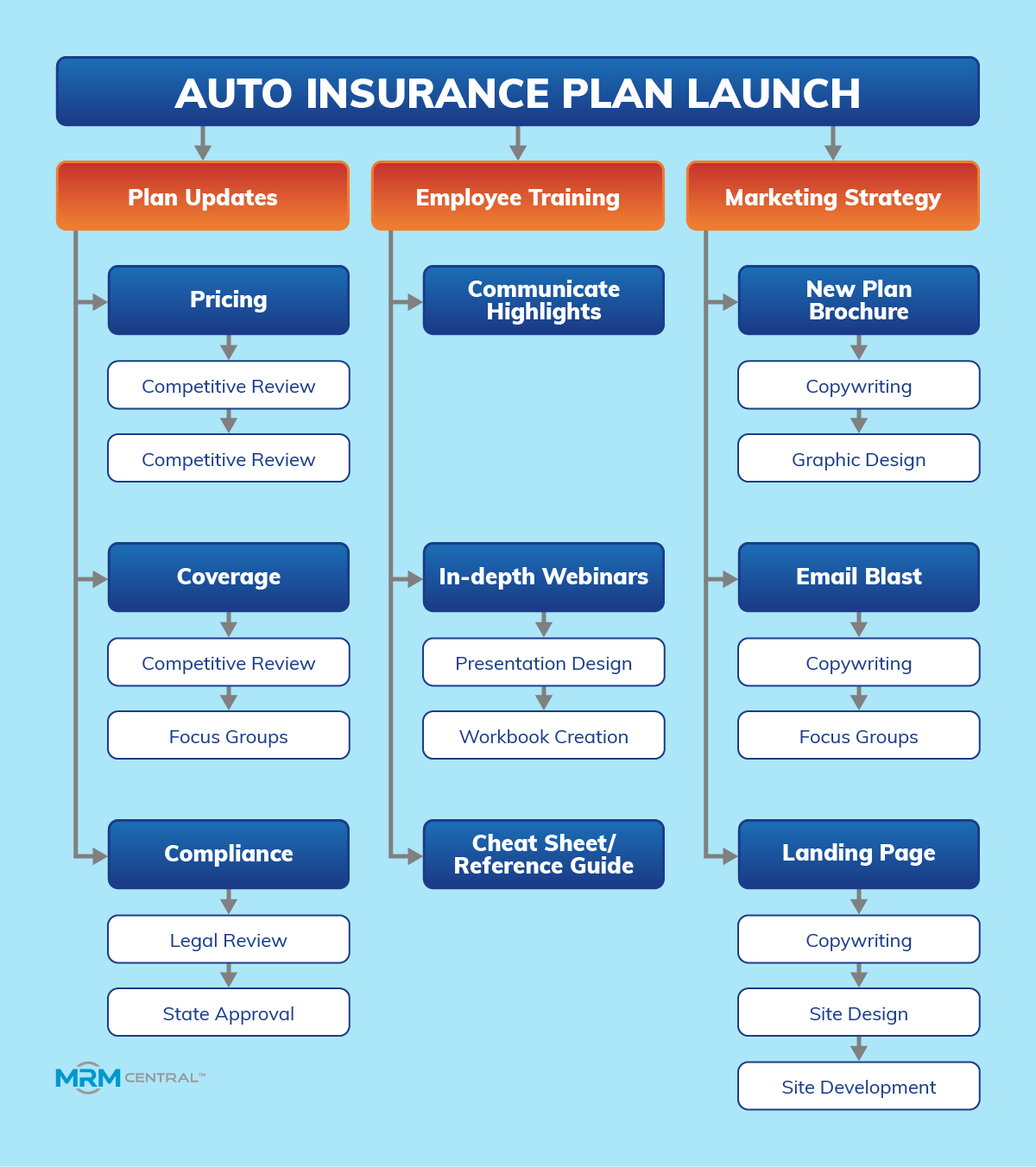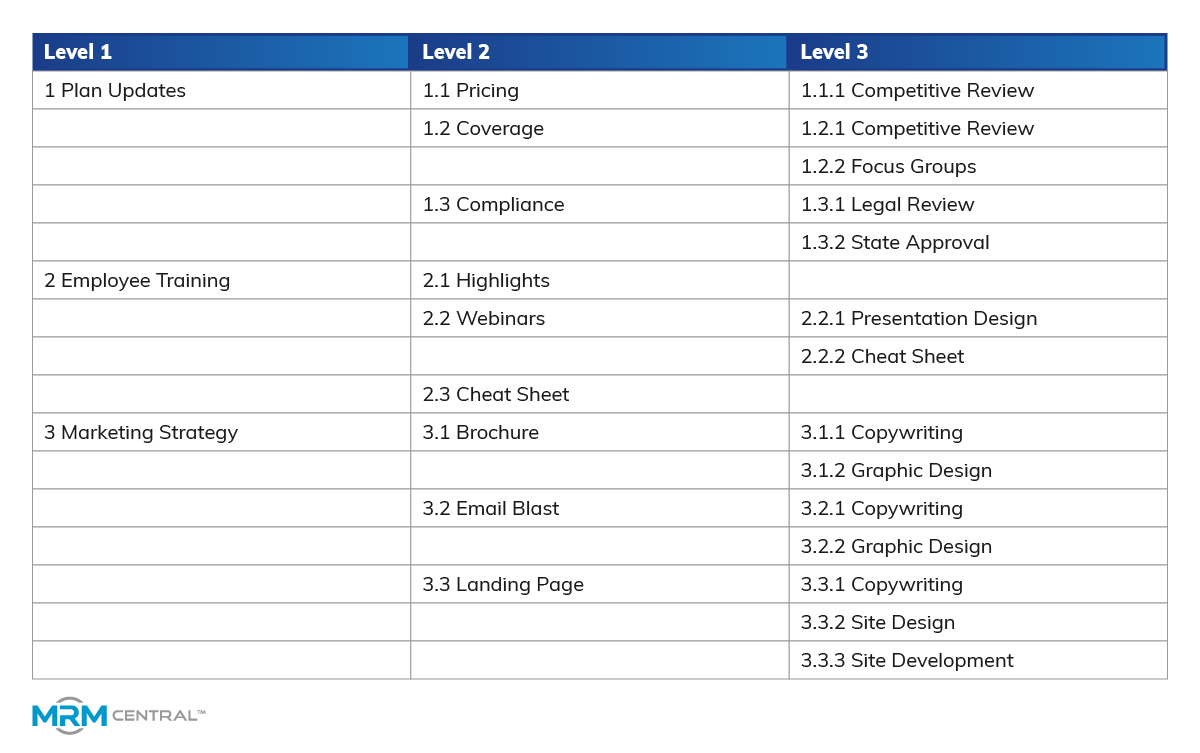30 Dec How to Create a Work Breakdown Structure (WBS) for Your Next Big Marketing Project
How to Create a Work Breakdown Structure (WBS) for Your Next Big Marketing Project
How do you eat an elephant? According to the old adage, you do it one bite at a time. Of course, we don’t recommend eating any endangered species… but it’s still a good metaphor for managing large projects.
If you’ve got a massive project you’re looking to tackle, you’ll want to break it down into smaller goals so you can:
• Get a realistic idea of how much time and labor is involved
• Build a coherent project timeline
• Budget correctly
• Communicate the project and its needs to executive leadership
• Identify and manage risks
• Assign responsibilities and project dependencies
A Work Breakdown Structure (WBS) will help you do just that!
What is a Work Breakdown Structure (WBS)?
A Work Breakdown Structure is a visual representation of all the work necessary to complete a project.
A well designed WBS focuses on outcomes, not actions—leaving detailed tasks for the project plan. Instead, a WBS uses a chart to break a major project into smaller, more manageable goals. Each objective is broken down further until every important milestone has been identified.
WBS Example: Home Warranty Plan Launch
The following is a hypothetical example of a Work Breakdown Structure for an auto insurance company that intends to launch a new plan in the state of California, with updated rates and coverage.
In order to remain competitive while earning a profit, the company needs to regularly release new plans with increased (but competitive) pricing and modified coverage that meets policy holders’ needs without breaking the bank in claims costs.
Here’s a simplified version what their WBS might look like for their new plan launch:

You’ll notice there are no tasks written out (e.g., review competitor pricing, write landing page copy). That’s because a WBS is all about listing and breaking down goals. Individual tasks required to reach those goals appear in the project plan, which the project manager will derive from the WBS.
Note: You don’t have to create a flowchart-style WBS. You can simply list each goal in a simple outline like the one that follows (using a decimal system to identify how larger goals break down into smaller ones).

What matters is that you have a clear understanding of each goal and how each sub-goal feeds into the larger objectives. Then you can use an integrated, digital and holistic project management platform (like MRMcentral) to build your timeline, manage workflows, and keep everyone on track.
Best Practices for Work Breakdown Structures
A solid WBS gives everyone—project planners, executives, managers, employees, and stakeholders—a bird’s eye view of everything that must be done to complete a large project. With that in mind, the following best practices will help you build a WBS that includes all the essential components without repeating itself or going into excessive detail.
Avoid Redundancy: Double check your WBS before distributing it to make sure you’ve listed each goal once… but only once! It can be easy to repeat yourself if you’re not careful.
Get the Right Level of Detail: How do you keep from going too granular or too broad? Apply the 8/80 rule. Simply ask yourself, “Will this goal take less than 8 hours or more than 80 hours to accomplish?” If it takes less than 8 hours, you can usually fold it into a larger goal. If it will take more than 80 hours, you’ll want to break it down into smaller goals.
Three Levels: You’ll notice in our sample chart that the main goal is broken down into three levels of sub-divided tasks (e.g., 1. Plan Updates > 1.1 Pricing > 1.1.1 Competitive Review). Although it’s not a hard-and-fast rule, three levels is usually sufficient to create a WBS that has the right amount of detail. That said, if you need to break it down further (which might be the case with exceptionally large projects), by all means, do what must be done.
Assigning Rolls
Once you’ve got a WBS, it’s time to assign each goal to specific teams or individuals. Make sure each stakeholder understands their role and how it fits into the larger project. You’ll then be ready to break each goal into smaller tasks, identify contingencies, and begin building your project timeline.
Keeping Track of Your Deliverables
There are a lot of moving parts when it comes to managing large projects within a Marketing department. You’ve got to think about approvals from managers and executives, rework, tasks management, version control, and more.
MRMcentral is a project management platform designed specifically for Marketing departments. Schedule a free demo today!

